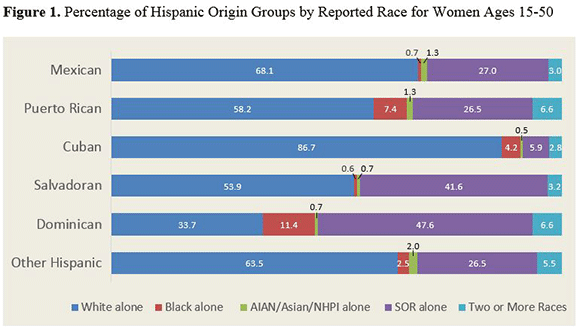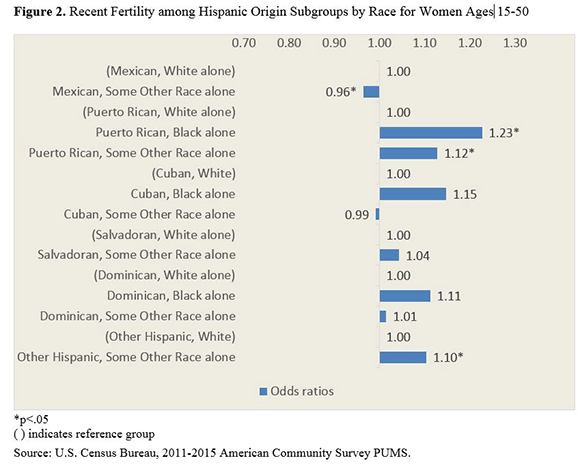Does Recent Fertility Among Hispanic Women Differ by Race?
Does Recent Fertility Among Hispanic Women Differ by Race?
The foreign-born Hispanic population has higher fertility compared to non-Hispanic groups in the United States. Fertility differentials across race and ethnicity often focus on comparing the following three categories: (1) all race groups not differentiated by Hispanic origin, (2) Hispanic people of any race group and (3) the non-Hispanic White alone population. Measuring the Hispanic population as a pan-ethnic group or as a single measure of “Hispanic people of any race group” can mask social and demographic differences of subgroups within the Hispanic population.
Hispanic origin refers to a person of Cuban, Mexican, Puerto Rican, South or Central American or other Spanish culture or origin. While Hispanic people may be of any race, over half of the Hispanic population racially identified as White alone and about one-third identified as Some Other Race alone in the 2010 Census.
When examining the reported race of Hispanic origin subgroups in the 2011-2015 American Community Survey, variations in the racial distributions for women ages 15 to 50 are clear. The racial distributions of the five largest Hispanic origin subgroups and a residual category, “Other Hispanic,” are shown in Figure 1. Among women of Mexican, Puerto Rican, Salvadoran and Other Hispanic origins, over half reported they were White alone and about one-third reported Some Other Race alone. However, the racial distribution for women of Cuban and Dominican origin differs. Among Cuban women, 86.7 percent reported White alone while only 5.9 percent reported Some Other Race alone. Among Dominican Women, 33.7 percent reported White alone and 47.6 percent reported Some Other Race alone. Black alone was the third largest reported race for Puerto Rican, Cuban, and Dominican women.
Note: AIAN refers to American Indian and Alaska Native; NHPI refers to Native Hawaiian and Other Pacific Islander; SOR refers to Some Other Race
Source: U.S. Census Bureau, 2011-2015 American Community Survey PUMS.
(For more information on the American Community Survey PUMS data visit <www.census.gov/programs-surveys/acs/>)
The American Community Survey measures recent fertility by asking whether women ages 15 to 50 had a birth in the last year. In order to examine if there are differences among Hispanic women by race, we examined recent fertility for each of the five largest Hispanic subgroups and one residual group by race presented as odds ratios.
Odds ratios can be used to show the probability of an event occurring compared to the probability of an event not occurring relative to a base population. Here, we use odds ratios to show the probability of giving birth in the last year relative to reported race of Hispanic origin subgroups. Figure 2 shows odds ratios of recent fertility for women of Mexican, Puerto Rican, Cuban, Salvadoran, Dominican and Other Hispanic origins by race.
(For more information on the American Community Survey PUMS data visit www.census.gov/programs-surveys/acs/)
For each Hispanic origin group, those who reported their race as Some Other Race alone were compared with those who reported White alone. The odds ratios show whether the probability of Some Other Race women having a recent birth differed from White alone women for that specific Hispanic origin group.
For the Puerto Rican, Cuban and Dominican Hispanic origin groups, those who reported their race as Black alone were also compared to those who reported White alone, because Black alone was the third largest reported race for Puerto Rican, Cuban, and Dominican women ages 15 to 50. The odds ratios show whether the probability of Black alone women having a recent birth differed from White alone women for these three Hispanic origin groups.
Odds ratios above 1.00 indicated a higher probability of having the event (higher recent fertility in this case) and odds ratios below 1.00 indicated a lower probability.
For example, Mexican origin women who reported they were Some Other Race alone have lower odds of giving birth to a child within the last year compared to Mexican origin women who reported White alone. Puerto Rican origin women who reported Black alone or Some Other Race alone had higher odds of giving birth to a child within the last year compared to Puerto Rican, White alone women. Other Hispanic women also experienced differences in recent fertility across race groups. Those who reported their race as Some Other Race alone had higher odds of giving birth to a child in the last year compared to Other Hispanic, White alone women.
There are no differences in recent fertility for Cuban, Salvadoran, and Dominican origin women across race.
For more information about this model of recent fertility by Hispanic origin subgroups by race, see the poster and please join us at the 2017 Population Association of America conference.
-X-





